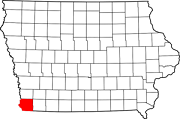|
Welcome to Fremont County Iowa
Genealogy Research
Robert Hunt
Robert J. Hunt was born
Apr, 1899 Greenwich Village, New York,
he died 1960 and is buried in Grandview
Cemetery, Sidney (Knox), Iowa
Robert was the son of Robert Hunt born
Aug 1875 in New York and
Margaret Hassen born Dec 1876 in New York.
Robert J. (Hunt) Hume married
Florence Snodgrass about 1926.
Florence was born about 1905 in
Sidney, Iowa and she died in 1981 and is
buried in Grandview Cemetery, Sidney (Knox),
Iowa.
Florence was the daughter of Mac
Snodgrass born about 1864 in Iowa
and Jane Bobbitt born Feb 13, 1865 in
Iowa.
Robert was adopted in 1904 by Guy and
Alma Hume and assumed the Hume name.
Children:
Robert M.
Hume
born Sept 5, 1927 in Thurman Iowa and
died Dec 6, 1981. He is buried in
Thurman Iowa.
Jerry
Hume
born
1934 in Thurman Iowa.
lowell Dean
Hume
born
1937 in Thurman Iowa
Jane
Hume
born Sept, 1939 in
Thurman Iowa.
Mary Frances
Hume
born
1943 in Thurman Iowa.
Jo Ellen
Hume
born
1947 in Thurman Iowa.
The following story was published by
Barbara Ann Dush of Fullerton Nebraska from
conversations with Jane (Hume) Clements
concerning
her father Robert to arrived on the
Orphan Train.
---------------------------------------------------------------------------------------------------------------------------------------------------------------------------------
Jane Clements points to a family photo
as she explains ancestral history about her
father and two aunts who came to Fremont
County, Iowa,
on the Orphan Train. Jane Clements has
a myriad of photos and information she's
gleaned about her father, Orphan Train rider
Robert J. Hunt.
She recalls memories of him as a
“wonderful” parent; and considering his
upbringing, Jane calls it nothing short of a
miracle.
“My dad was adopted by a couple with
the last name of Hume who had a son that
died, and he would have been the age of my
dad. That was
the reason they wanted a child;
however, it would have been much
better had they never taken him and he could
have gone to a better home.
It's a miracle my dad turned out to be
a nice man.”
Robert Hunt was born in 1900 in
Greenwich Village, New York City. In 1901,
his family gave his sisters Margaret and
Sadie away to the Five
Point House of Industry in New York
City, but the family kept Robert for a
period of time.
The Five Point House of Industry
orphan home was established in 1851 by Rev.
Lewis Pease, who conducted its affairs for
nearly three years
without public aid. It was located in
what was then the “most depraved and
wretched portion of the city.”
In 1904, a few months after Robert was
also taken to the Five Point House of
Industry, Robert and sisters Margaret and
Sadie were moved to the
Children's Aid Society. Soon after,
they were put on the Orphan Train.
“My aunt said they fed them raspberry
jelly sandwiches on the train. She also
talked about coming halfway from New York
and some of the kids
got head lice, so they had to stop the
train and cut hair and other things to
get rid of head lice.
“There were 17 kids brought to Sidney,
Iowa. They were given away at the front of
the Methodist Church in Sidney. The church
had just been
built and paid for at that time, and
the same church is still here.”
ROBERT WAS 4-years-old, Sadie was
around six and Margaret close to 11 years of
age when they arrived in Iowa.
Sadie was chosen by Mrs. Melissa
Hutchinson. The couple had three boys and
she wanted a girl.
“They raised Sadie and gave her a lot
of advantages,” Jane said of her aunt. “The
day she was taken, Aunt Sadie said Mrs.
Hutchinson gave her
a little bracelet and a bag of candy
when they went to go home.
Before they got to Anderson, Iowa,
just a little north of Sidney, she said,
‘I'll give you back the bracelet and the
candy if you give me back my
sister'.”
Mrs. Hutchinson proceeded to tell
Sadie she was not taking her sister away
from her and that she would get to see her.
However, the words
didn't satisfy Sadie's longing for her
sister and she didn't eat well for several
weeks. The Hutchinsons finally took her to
see Margaret and Robert,
who were temporarily staying with
their great-grandparents. The three childen
were able to stay in contact as they grew
up.
Sadie was never adopted by the Hutchinsons.
She eventually married and was a telegrapher
and had her own telegraphy office in
Shenandoah. “She sent out the telegram about
the gold standard that
(President Franklin D.) Roosevelt put
out and sent to the banks. That was one of
the things she was most proud of in her
career,” Jane said.
Sadie went on to work in an orphanage
in Council Bluffs, and had an apple orchard
in Tabor. “It meant so much to her because
she remembered
fresh apples being brought into the
home in New York City. They would each get
one apple and Aunt Sadie and her friend
would take one bite
out of an apple a day and save it for
the next day.”
MARGARET LIVED IN a number of homes, a
fact Jane discovered during a casual
conversation with a stranger.
“After Jim and I were married and
lived in Leon, Iowa, I was visiting with a
woman across the street from his aunt and
uncle's home. She didn't
know me and asked me about my
background and family, and I commented
my dad had come on the Orphan Train.”
The woman told Jane she knew a girl
that came on the Orphan Train. When Jane
inquired as to what her name was, the lady
replied “Margaret
Hunt.”
“I told her that's my aunt; but that
couldn't be, she was never over here.”
After the woman described Margaret,
Jane knew it was her aunt. “The woman said
the meanest family you could imagine took
her. Finally they
came and removed her. I told my dad
about this and he said Margaret was
never at that place.
“In later years in talking to my aunt,
she didn't admit it. So I talked to her
daughter, and she said her mother wasn't
there. They got to talking to
her and Aunt Margaret admitted she was
taken to this place. They were so mean to
her she'd blotted it out.”
Margaret was moved to three other
homes around Clarinda and Shenandoah before
she settled in with a family in Afton, Iowa;
however, like her
sister, she was never adopted.
Margaret later married and moved to
California. After raising her family, she
went back to school and taught until she was
past 80 years old.
ROBERT WAS CHOSEN by the Hume family.
“My dad probably had the worst life of
all three of the kids because of the couple
that raised him. The father was an
alcoholic, plus the drug of
choice at that time was opium and they
put him in an institution for that at one
time. The mother also began to drink, plus
she was a mean
personality woman anyway. She used to
tell my dad on a regular basis ‘you're just
an adopted brat'.”
Jane obtained the census records and
discovered more about the Hunt family,
“which really thrilled my aunts,” she said.
“That's the first time
Aunt Sadie ever knew she lived with
her parents in her own home. When she saw
that, she said ‘we were a family at one
time'.”
At the time Jane's dad was given away,
his father was out of work for a lengthy
period of time. The census revealed he was a
driver.
Jane also learned members of the Hunt
family were very musical and entertained on
the weekends in New York City.
“My dad hated the accordion and I
don't like it either. I found out his father
played an accordion. Perhaps they found out
they were given away
by a man that played an accordion ...
I don't know.”
Despite not being able to finish the
8th grade, Robert became a self-educated man
and very well read. He went on to do
carpentry and concrete
work and farmed.
“If there was anything to do he could
do it,” Jane said with a daughter's proud
smile. “He was a blacksmith, and I spent my
life between one and
five in his blacksmith shop with him.
I have wonderful memories of that time. We
weren't rich in money, but we were rich in
other things.”
|
|

Robert and Sarah Hunt circa 1910
|
|
_Clements.jpg)
Jane
(Hume) Clements daughter of Robert
(Hunt) Hume
|
©
JenkinsGenealogyResearch All Rights
Reserved.
This site last updated:
|




_Clements.jpg)